Before we start to expand the course, we recommend that you take a moment to plan your course so that it complies with standards and recommendations that have been set to accommodate students' diverse needs and abilities. To do so, we will follow what is referred to as the Universal Design for Learning (UDL), which are guidelines that assure accessibility services for individuals with disabilities.
In this section, we will look at legal requirements but keep in mind that the Universal Design for Learning has its roots in ethics, human dignity, and the belief that all individuals deserve to have access to education.
However, in returning to legal frameworks that assure accessibility services to individuals who may have disability issues, let's remember that we must comply with the laws and regulations that have been enacted to provide equal access to them. In the United States, the Americans with Disabilities Act (ADA) (1990) protects the civil rights of individuals living with disabilities and requires academic organizations to make educational programs available to students with disabilities. Do not forget to check for similar laws and regulations in your region since they vary from country to country.
We know that each student has a unique set of abilities and strengths and we also realize that all students possess their own learning styles. So, we need to make sure to design courses that are compliant in the following ways and follow the guidelines set forth in the Higher Education Opportunity Act of 2008; they follow three primary principles as listed:
- Multiple means of representation
- Multiple means of access and expression
- Multiple means of engagement
In an online course, and a learning management system such as Moodle, you have the flexibility to comply with the previous three principles. For a complete guide to the Higher Education Opportunity Act of 2008, you may visit the U. S. Department of Education website at http://www2.ed.gov/policy/highered/leg/hea08/index.html.
Depending on where they live, students with disabilities or special needs may qualify for government-funded programs that provide them with financial support or low-cost assistive technology.
At this point, you may be feeling very nervous and overwhelmed about adhering to complicated rules and regulations. Don't worry; assistive technology has made great strides in the last few years, and many such technologies are very low cost and easy to implement. For example, there are many text-to-voice screen readers and voice recognition programs that convert the spoken word to text. Grand Canyon University has put together an excellent list, which you may find at http://www.gcu.edu/Disability-Office/Assistive-Technology.php.
Don't forget that reasonable accommodation can be achieved in many different ways, ranging from assistive technologies to something as simple as finding a person who can read to a vision impaired learner.
The most important consideration when you're planning your course is preparation. Prepare for students with diverse abilities and needs and design a course that builds in the multiple means concept in the Higher Education Opportunity Act of 2008. Remember that it's much more difficult to redesign and retrofit your course than to design it well from the very beginning.
As you plan your course and select course material, remember that you should provide a choice of materials that allow students to achieve the learning outcome. What this means in practical terms is that if you are providing text, you will need to ensure to provide it in a form that can be read by a screen reader for vision impaired learners. If you are providing videos, you will need to include a script for hearing impaired readers. A simple way to achieve this principle is by building in redundancy.
As you build your course, be sure to provide different ways for students to act and interact. For example, instead of simply providing readings and quizzes, you may wish to include a discussion forum where you ask your students to discuss questions that help them learn the material and to share drafts of their papers.
You may also want to build in activities that allow students to express themselves by creating documents that include graphics as well as text. In a different case, if you have a student who has difficulty typing, you may allow him/her to turn in an audio recording.
Student engagement means that students are interacting in the course. They may be interacting with automated quizzes or be engaged in a discussion with their peers. They may also be asked to go online and conduct research.
Moodle has built in many activities that encourage students to use different ways in which to engage with the material in a course. In addition to the forum and a wide array of activities, Moodle also integrates with web conferencing software programs and services, such as BigBlueButton, and offers integration with Skype.
